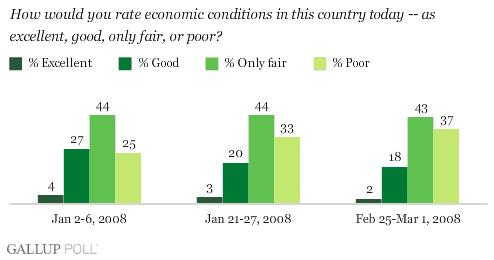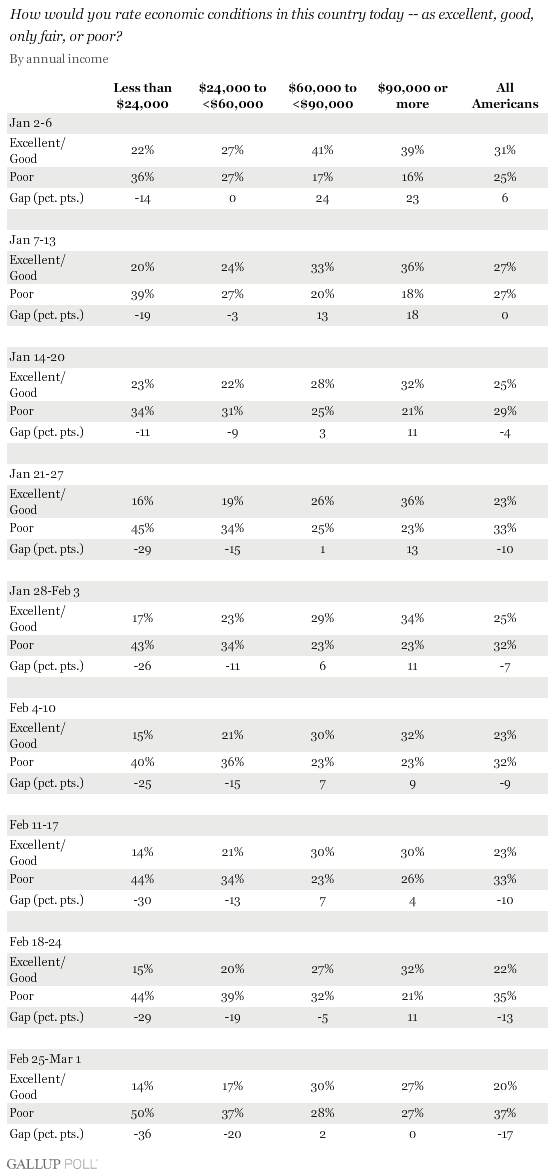PRINCETON, NJ -- The gap between the percentage of Americans rating the economy "poor" and the percentage rating it "excellent or good" was at its highest level of 2008 as March began.

Consumer Ratings Show Declining Weekly Trend
Last Friday, Reuters and the University of Michigan reported that its Index of Consumer Sentiment decreased from 78.4 in January to 70.8 in February. This follows the preliminary Index reading of 69.6 for February and places consumer sentiment at its lowest level since February 1992.
Gallup's daily tracking of Americans' economic perceptions provides significant new insights into what has actually happened to consumer confidence over the first nine weeks of 2008. During the first week of January, more consumers rated current economic conditions "excellent" or "good" (31%) than rated them "poor" (25%), for a gap of +6 percentage points. By the fourth week of the month (Jan. 21-27), these percentages had reversed, with about one in four consumers rating the economy as excellent or good (23%) while one in three rated it as poor (33%), for a gap of -10 points. After improving slightly in early February, consumer ratings continued deteriorating: during the week of Feb. 25-March 1, only 20% gave the economy an excellent or good rating and 37% gave it a poor rating, for a gap of -17 points.
Ratings Gap Is Climbing the Income Distribution Scale
As might be expected, lower-income consumers were consistently more likely to be pessimistic about current economic conditions than was true for higher-income consumers over the first nine weeks of 2008. What might not be expected or understood is the way consumer pessimism is spreading across consumer income groups.
During the first week of January, 22% of those making less than $24,000 a year rated current economic conditions as excellent or good while 36% rated them as poor, for a gap of -14 percentage points. At that time, the comparable gap among those making $24,000 to less than $60,000 a year was 0. In sharp contrast, the gap among those making $60,000 to less than $90,000 was +24 and among those making at least $90,000, it was +23.
Over the past nine weeks, economic ratings have deteriorated across all income groups. By the week of Feb. 25-March 1, the gap among those making less than $24,000 had increased to -36; the early January gap of 0 among those making $24,000 to less than $60,000 had become -20; and among those making $60,000 to less than $90,000 annually, January's +24 gap had become +2. The early January gap of +23 among those making $90,000 or more a year was now 0.

More Bad News for Mid-Tier Retailers
In another Friday report, the Commerce Department reported that January consumer spending was essentially flat on an after-inflation basis for the second consecutive month. At the same time, mid-tier retailer Target reported that it has lowered its sales expectations for the first half of 2008. These trends seem consistent with the steady decline in consumer economic perceptions -- particularly because such pessimism has increased among consumers who usually make their purchases at retailers like Target.
More importantly, the continued deterioration in consumer ratings across ever-higher income groups during recent weeks suggests that these trends are not only continuing but intensifying. In turn, this indicates that real consumer spending will probably continue to decline in March. While the "move-down" of middle-income consumers to retailers serving lower-income consumers (such as Wal-Mart) may benefit these retailers, this is not good news for retailers serving middle-income consumers or for the overall U.S. economy over the months ahead.
Survey Methods
The results reported here are based on combined data of approximately 3,500 interviews conducted each week during 2008. For results based on these samples, the maximum margin of sampling error is ±2 percentage points. In addition to sampling error, question wording and practical difficulties in conducting surveys can introduce error or bias into the findings of public opinion polls.
